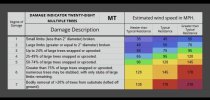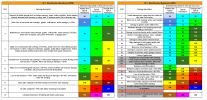Also one more thing I want to circle back to something another user posted about. This sort of got glazed over and buried in the thread, but it’s extremely significant. In the proposed new scale, root ball displacements (trees getting ripped out of the ground and thrown) have an expected damage starting at EF4 and can be rated EF5.

That’s huge! That means we have another way besides the “Enderlin method” to rate tornadoes EF5 independent of any structural damage. While “greater than typical resistance” hasn’t been defined yet, people have pointed out that a tree with no leaves would give the wind less surface area to grab onto. People have also pointed out that this happened in Bremen. How crazy would it be if Mayfield finally gets the rating it deserves based on tree damage?
Also, adjusting to this “new” definition of EF5 damage and this much less conservative approach to damage surveying has honestly left my head spinning. It’s been a bit of an adjustment. So many tornadoes that I’ve said “don’t meet the stringent EF5 criteria”, now can meet that criteria between the standards used in Jim LaDue’s presentation, the upcoming new tree scale, and by using mathematics to calculate windspeed to move heavy objects. I’ve gone from defending Mayfield’s high-end EF4 rating not because I agree with it, but because of the standards being used at that time, to realizing Mayfield now can likely be rated EF5 in some way due to the standards changing. I always go by what the current EF scale practices are, and as a result, my definition for what constitutes as EF4 and EF5 damage has dropped a s**t-ton essentially overnight. Not that this is a bad thing at all, as I just want to see accurate ratings too.

That’s huge! That means we have another way besides the “Enderlin method” to rate tornadoes EF5 independent of any structural damage. While “greater than typical resistance” hasn’t been defined yet, people have pointed out that a tree with no leaves would give the wind less surface area to grab onto. People have also pointed out that this happened in Bremen. How crazy would it be if Mayfield finally gets the rating it deserves based on tree damage?
Also, adjusting to this “new” definition of EF5 damage and this much less conservative approach to damage surveying has honestly left my head spinning. It’s been a bit of an adjustment. So many tornadoes that I’ve said “don’t meet the stringent EF5 criteria”, now can meet that criteria between the standards used in Jim LaDue’s presentation, the upcoming new tree scale, and by using mathematics to calculate windspeed to move heavy objects. I’ve gone from defending Mayfield’s high-end EF4 rating not because I agree with it, but because of the standards being used at that time, to realizing Mayfield now can likely be rated EF5 in some way due to the standards changing. I always go by what the current EF scale practices are, and as a result, my definition for what constitutes as EF4 and EF5 damage has dropped a s**t-ton essentially overnight. Not that this is a bad thing at all, as I just want to see accurate ratings too.

